The New Year brings a new colour, which, according to WGSN, is Transformative Teal.
Colour of the Year 2026 is:
“A fluid fusion of blue and aquatic green that reflects the diversity of nature and taps into an Earth-first mindset. It represents change and redirection, and can help encourage resilience in the face of complex climate challenges.”
(see Colour of the Year 2026: Transformative Teal)
In this post, Transformative Teal: 2026 Colour of the Year Explained, you can find out more about the history and meaning of the 2026 colour of the year.
Teal in Fashion & Media
As seen in the article “Spotted on the Catwalk: WGSN and Coloro’s Colour of the Year 2026 ‘Transformative Teal’” by FashionUnited, the hue has already surfaced across luxury and designer brands in late 2024 and early 2025 runway shows.
It is presented through eveningwear, outerwear, and sport-tailored pieces, highlighting teal/blue-green looks at Elie Saab, Denzil Patrick and others.
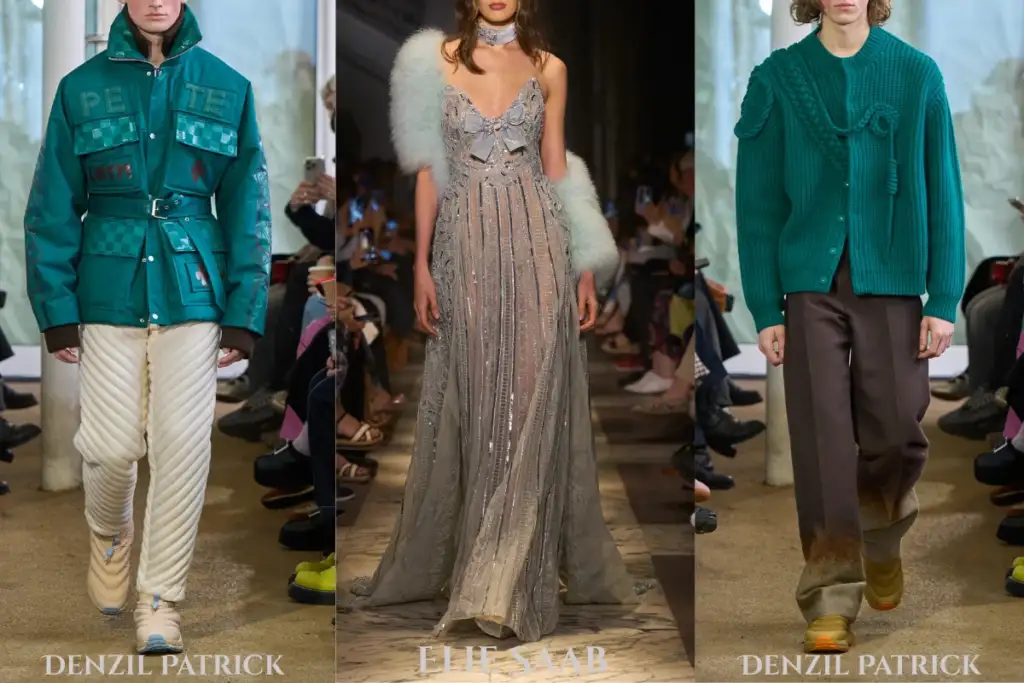
The most famous use of a colour close to Transformative Teal in luxury branding is Tiffany Blue (a robin-egg blue custom Pantone and colour trademark since 1998). (see Pantone on Tiffany Blue, Wikipedia).
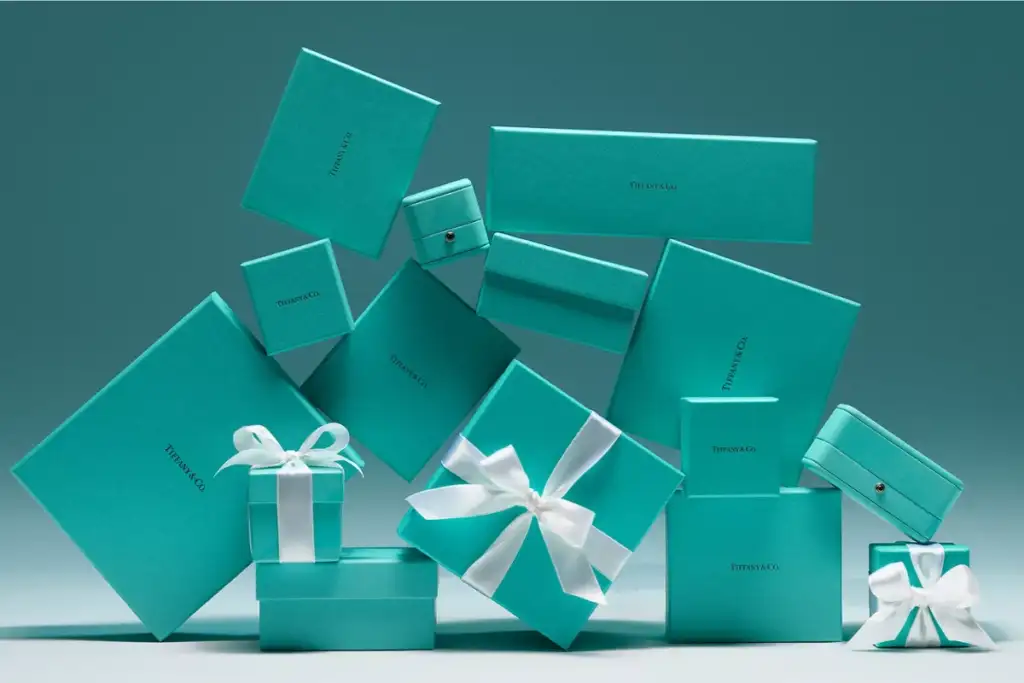
According to “Teal” by Color Psychology, tech, healthcare, and education fields favour teal for its calm, trust, and reliability, where it stands as a premium yet approachable signal across apparel, uniforms, UX, and visual identities. (
As stated in “Colour of the Year 2026: Transformative Teal” by WGSN:
“According to WGSN research, 98% of respondents say their purchasing decisions are influenced by colour. Colour plays a fundamental role in the identity of brands and their products, and the relationship between colour and emotion must now be a commercial consideration for brands.”
How to Identify Your Perfect Shade of Teal
Finding the right shade of teal depends on skin undertone. Picking the wrong hue can flatten your complexion or emphasise redness or sallowness.
Step-by-Step Guide
1) Identify Your Undertone (Cool/Warm/Neutral). Use the white-vs-cream test and jewellery test (silver vs gold) in daylight. These are some of the standard methods and a great first filter for picking the right colour shade.
- Cool undertones → bluer teals (aqua, marine, ink-blue)
- Warm/olive undertones → greener teals (jade, tropical teal)
- Neutral undertones → mid-teal balanced between blue and green
2) Check Your Contrast Level
People with high contrast (e.g., dark hair with light skin) wear deeper, higher-contrast shades well, while people with low-contrast colouring often flatter softer, medium-value shades or head-to-toe tonal looks. Learn about your personal value/contrast and echo it in your outfit so the colour accompanies your natural beauty, rather than taking the lead.
3) Do a Colour Test in Daylight
Sit by a window, preferably without makeup, and alternate colour swatches (bluer vs. greener, lighter vs. darker, muted vs. vivid). Keep what makes your skin look clearer, eyes brighter, and shadows less pronounced. This is the classic method colour analysts use.
Pro Tip: To analyse the results better, take a short video with your phone’s front camera, so you can take screenshots of yourself wearing those colours for reference later to compare how each shade enhances your skin clarity and eye brightness
4) Choose Fabric & Finish Wisely
Choosing the right fabric can be a great tool, helping you achieve your goal. As an instrument, lustre and surface reflection are fundamental textile properties that change how we perceive the same dye. Therefore, glossy/silky fabrics reflect more light and can make teal read brighter or “bluer”; matte/lofty textures (wool, brushed cotton) mute and “green” a shade.
- Glossy/silky fabrics → read brighter or bluer
- Matte/lofty textures → look deeper or greener
5) Test for On-Camera Colour Cast
Teal can reflect greenish tones in the face in photos/video, especially outdoors. Blue-greens can project onto skin, especially outdoors near foliage or with large areas of coloured garments close to the face. In these cases, it is probably better to keep bold colour in the lower half of your body. Alternatively, if necessary, keep in your portrait zone in a moderate amount as part of an accessory group. (see Fstoppers)
Colour Pairings That Work Best
Transformative Teal is a versatile, subjective shade that shifts between blue and green tones depending on what it’s paired with, making it a true chameleon. Whether styled as a monochromatic look or contrasted with bold tones like orange, it creates uniquely harmonious and elevated aesthetics (Who What Wear).
Key Pairing Ideas
Deciding on your wardrobe colour palette first would make it much easier to identify teal colour combinations that would suit your everyday lifestyle. Depending on your lifestyle categories, you can decide whether to bring teal into your wardrobe as an accessory colour or to incorporate it into your everyday style.
Let’s take a look at some possible colour combinations that may be helpful when considering how to incorporate teal into your wardrobe.
The Forever-Polish Neutrals (Work, Presentations, Interviews)
The most versatile way to incorporate teal into your wardrobe is to pair it with soothing neutral colours, such as beige, camel, cream, navy, grey, or even black and white, to achieve timeless, balanced, and polished combinations perfect for professional settings.
Metallics like gold and silver act as “new neutrals,” with gold warming greener teals and silver flattering bluer tones. Think: a teal blazer with a cream silk blouse and charcoal trousers, or a teal knit paired with a camel skirt (as seen in Who What Wear).
- Pair with beige, camel, cream, navy, grey, black, or white for timeless looks. Metallics like gold warm up greener teals, while silver flatters bluer tones.
Analogous Harmony: Teal × Blue × Green (Editorial, Tonal, Elegant)
To achieve an analogous, tonal harmony, combine teal with deeper shades of teal, turquoise, or navy for rich, editorial-ready outfits. These combinations create an elegant, luxe vibe often seen in street style and runway editorials.
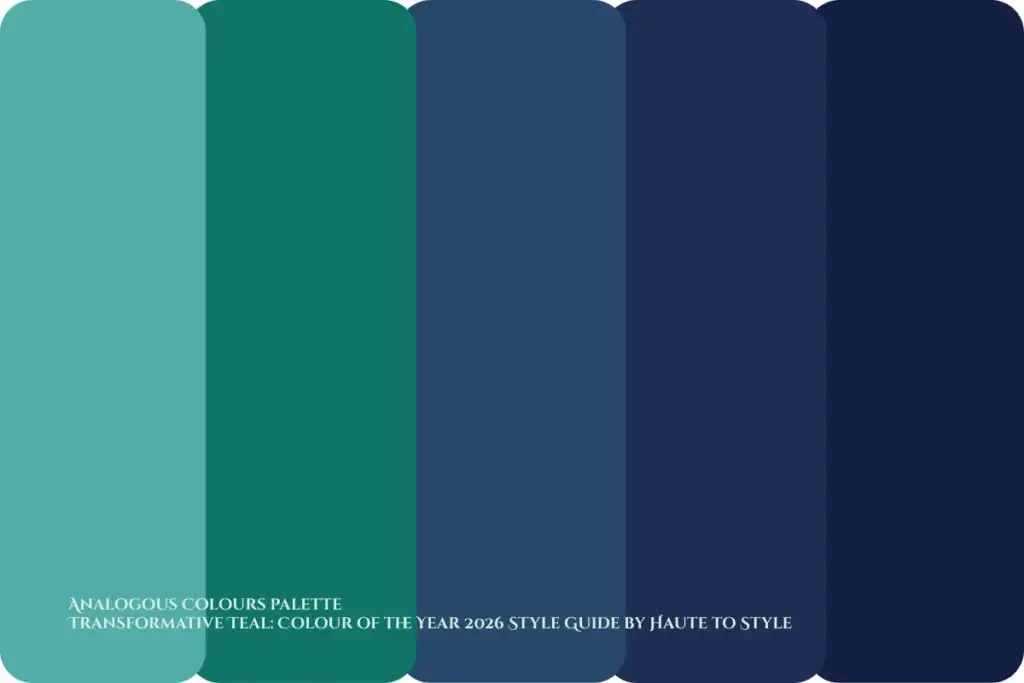
- Combine teal with deeper shades of teal, turquoise, or navy for rich, editorial-ready outfits.
Monochromatic Styling
Monochromatic looks continue to dominate, conveying a sense of elegance. A head-to-toe teal outfit in mixed textures, such as satin, wool, or leather, creates a luxurious, runway-inspired finish.
- Head-to-toe teal in mixed textures, such as satin, wool, or leather, exudes runway-inspired luxury.
Complementary Pop: Teal × Coral/Red-Orange (Statement Looks, Events)
For bold, statement-making looks, opt for coral or a red-orange hue. According to classic colour theory, these shades are complementary opposites to teal—ideal for large accessories, such as bags or shoes.
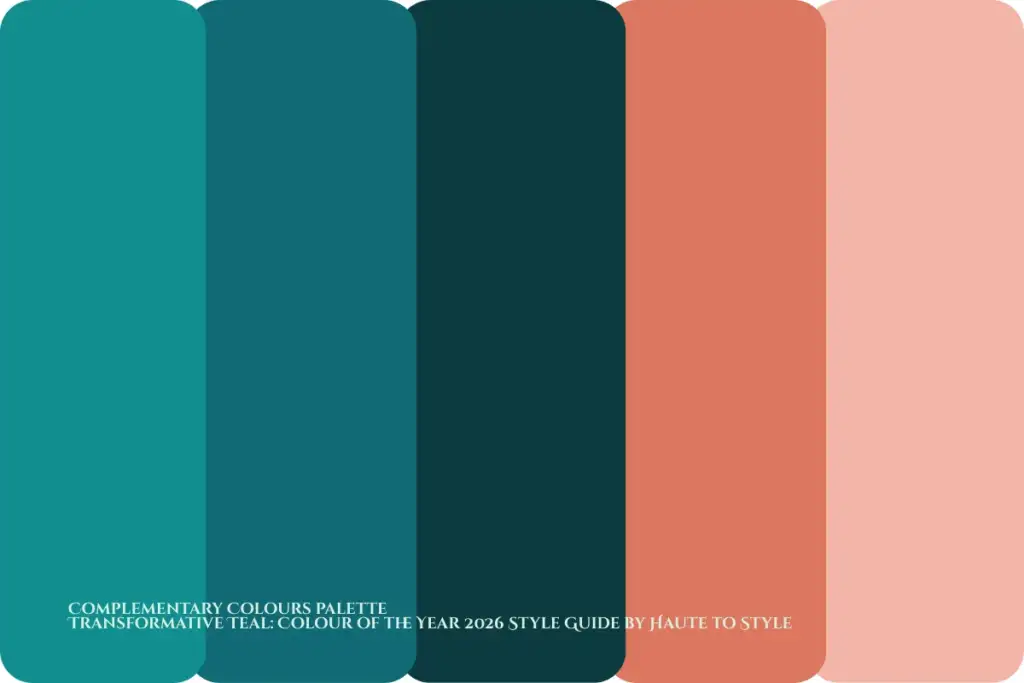
- For bold, attention-grabbing styles, pair teal with coral or red-orange.
Triadic Energy (Fashion-Forward Colour-Blocking)
For those seeking fashion-forward statements, consider triadic colour-blocking: pair teal with amber or fuchsia for bold, graphic looks. Triadic palettes, which are built using Adobe or Canva, preserve visual balance while making a strong statement.
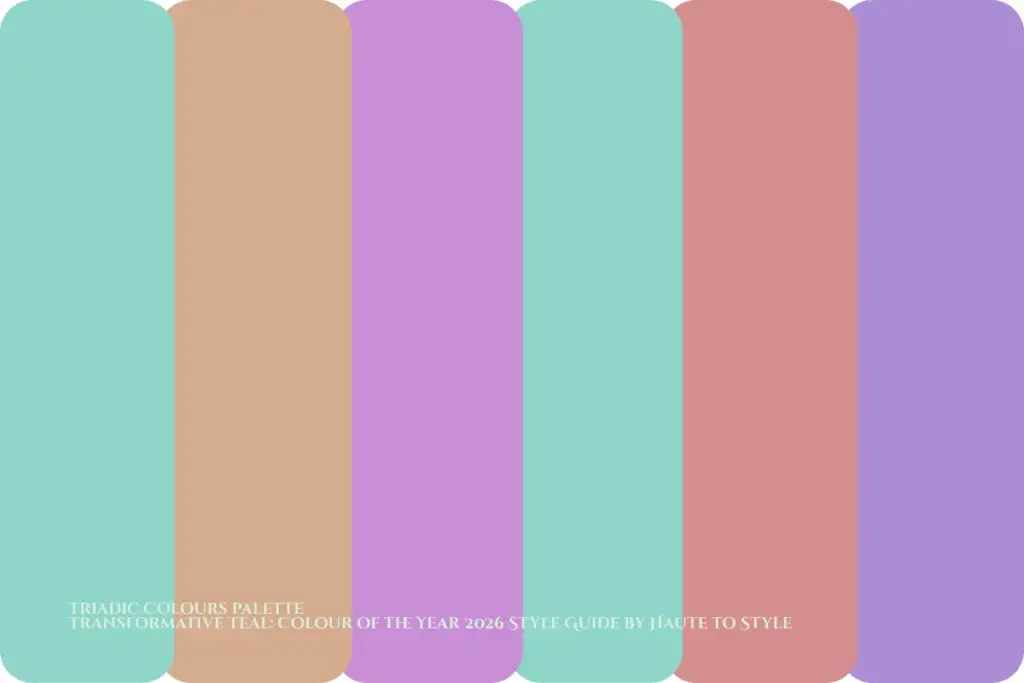
- Experiment with teal, amber, and fuchsia for visually striking, balanced outfits.
2026 “Pro” Pairings from WGSN Palettes
According to WGSN and FashionUnited, Spring/Summer 2026 trend pairings include Transformative Teal with Electric Fuchsia, Blue Aura, Amber Haze, and Jelly Mint, which are perfect for runway-ready, trend-aligned outfits. Even looking at Fall/Winter 2026-2027, whether it’s winter or summer outfit styling (depending on your location), pairing teal with creamy off-whites and grounded natural shades for a seasonal update will work every time.
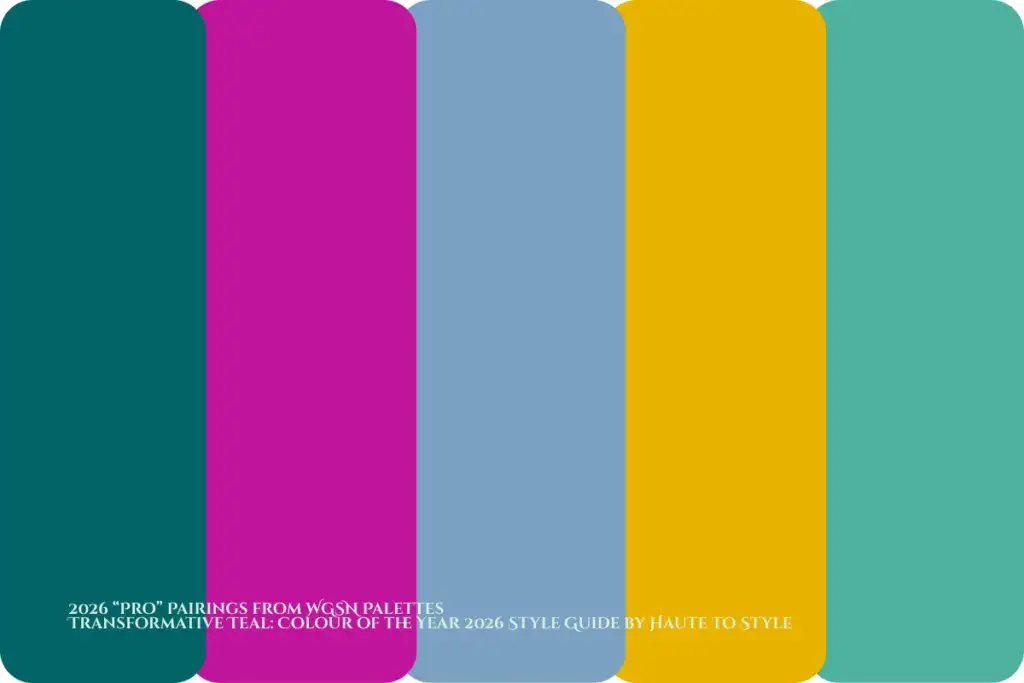
To plan your own wardrobe pairings, use free tools like the Adobe Colour Wheel or Canva Colour Wheel to build complementary, analogous, or triadic palettes for shopping and styling.
Challenges of Wearing Transformative Teal
Online vs Reality
Teal often looks different under various lighting conditions (warm indoor light versus daylight). It is also essential to examine the fabric it is made of, as materials may vary across brands and batches. Check your teal in multiple lights, read reviews, and shop from vendors with generous return policies.
- Lighting differences can alter teal’s appearance. Always check in multiple settings and read fabric reviews.
Colour Longevity
Deep hues can fade with light and wear. Prolong colour by limiting sun exposure, washing delicately, and aligning fibre/dye types when creating sets (Contract Textiles).
- Deep hues fade with light or harsh washing. Use gentle detergents and wash inside out.
Uniform Associations
In some industries, teal is associated with uniforms (e.g., scrubs, airline staff). To avoid the “uniform vibe,” mix textures or use teal as an accent rather than a complete look.
- Teal may evoke uniforms in some industries — style with varied textures or limit it to accessories.
Avoiding Over-Saturation
Teal is rich and saturated—if paired with too many brights, it becomes overpowering. Use a colour wheel to create balance: analogous for harmony, complementary for punch, and limit bright accents to one per outfit (Adobe Colour Wheel).
- Anchor bold teal with neutrals for balance, adding only one accent colour for harmony.
What to Buy: Garments & Use-Cases
Work & Presentations
For workwear, a teal blazer or tailored suit instantly modernises neutrals, so pair a teal jacket with cream, grey, navy, or black separates for polished outfits (think silk blouse, charcoal trousers) (Runway tailoring at Boss, Burberry).
- Teal blazers or tailored suits for a polished update to neutrals.
Occasion/Evening
For evening & events, teal satin/silk gowns and cocktail dresses photograph richly and read luxe on runways—recent catwalk roundups highlight blue-green evening looks at Elie Saab and others, confirming the hue’s formalwear credibility. Bias-cut satin dresses, velvet tailoring, crystal-trim knits (see Elie Saab and Zankov colour stories).
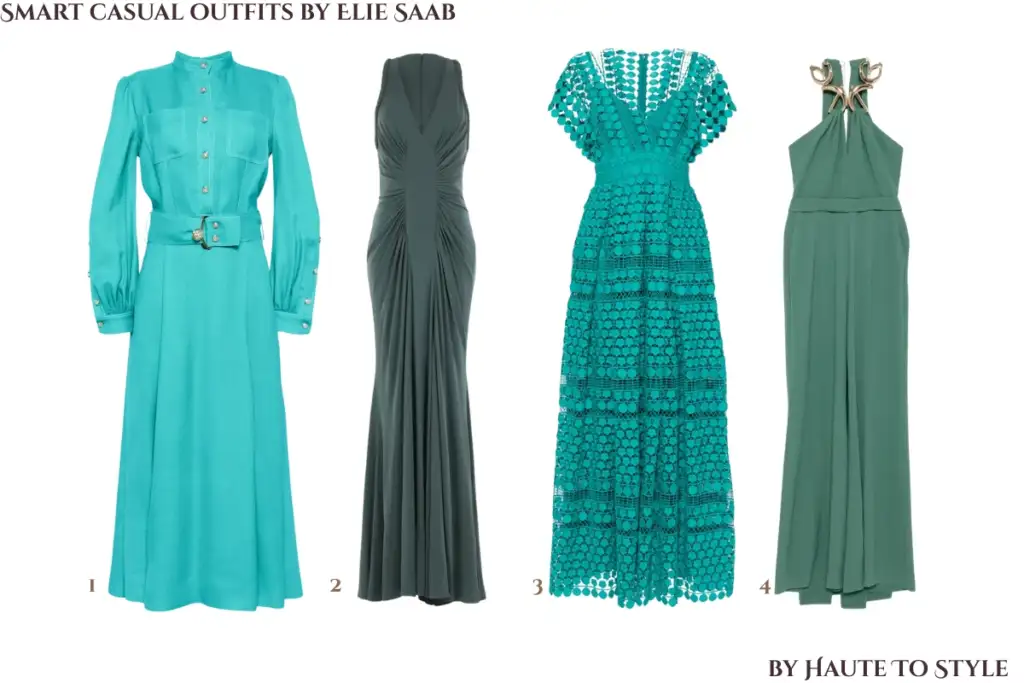
- A-line belted maxi dress | 2. Draped dress | 3. Macramé silk maxi dress | 4. Cady jumpsuit
Satin or silk gowns and cocktail dresses for events — as seen on the runways at Elie Saab and others.
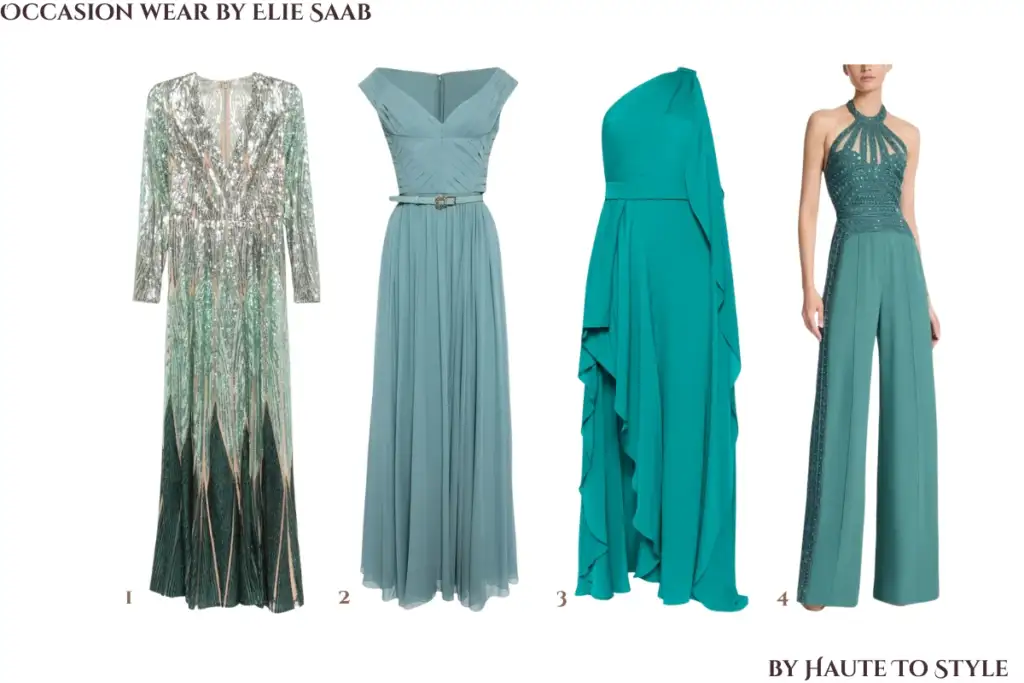
- Embroidered tulle long dress | 2. Off-the-shoulder silk dress | 3. One-shoulder silk gown | 4. Beaded jumpsuit
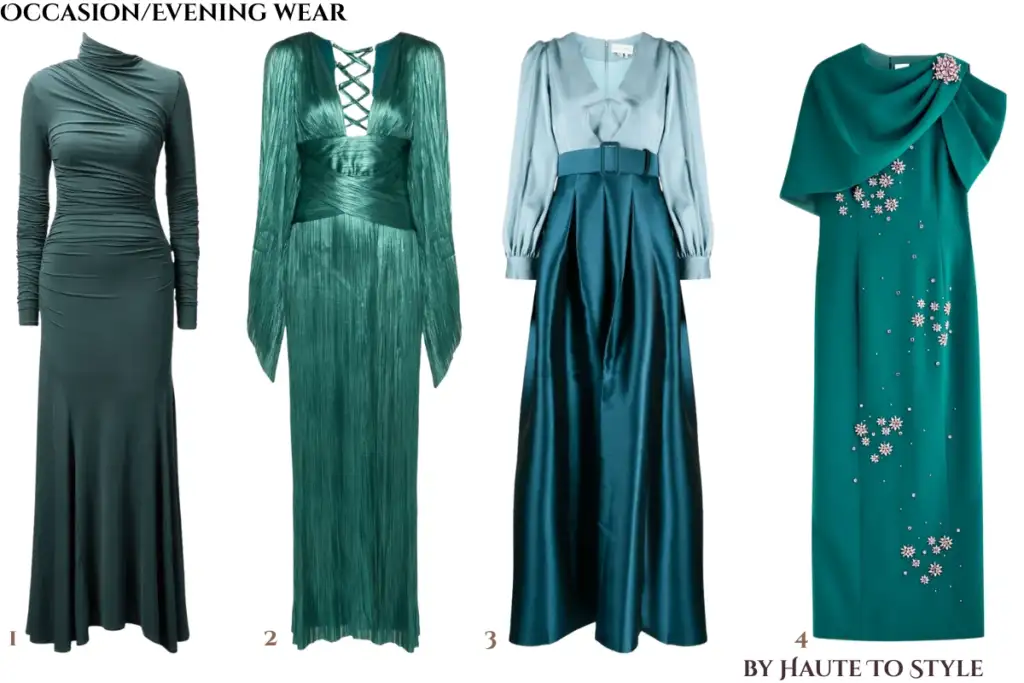
- Africa maxi dress | 2. Alana plissé silk gown | 3. Zoe belted satin gown | 4. Isolde gown
Smart-Casual
If you’re building a capsule, add knitwear (such as a crewneck or turtleneck) and a silk blouse in teal: these mid-layer staples anchor office and smart-casual looks while slotting into 2026 palettes forecasted by WGSN x Coloro (Transformative Teal as Colour of the Year) for long-term relevance.
- Knitwear or silk blouses that easily transition from office to weekend wear.
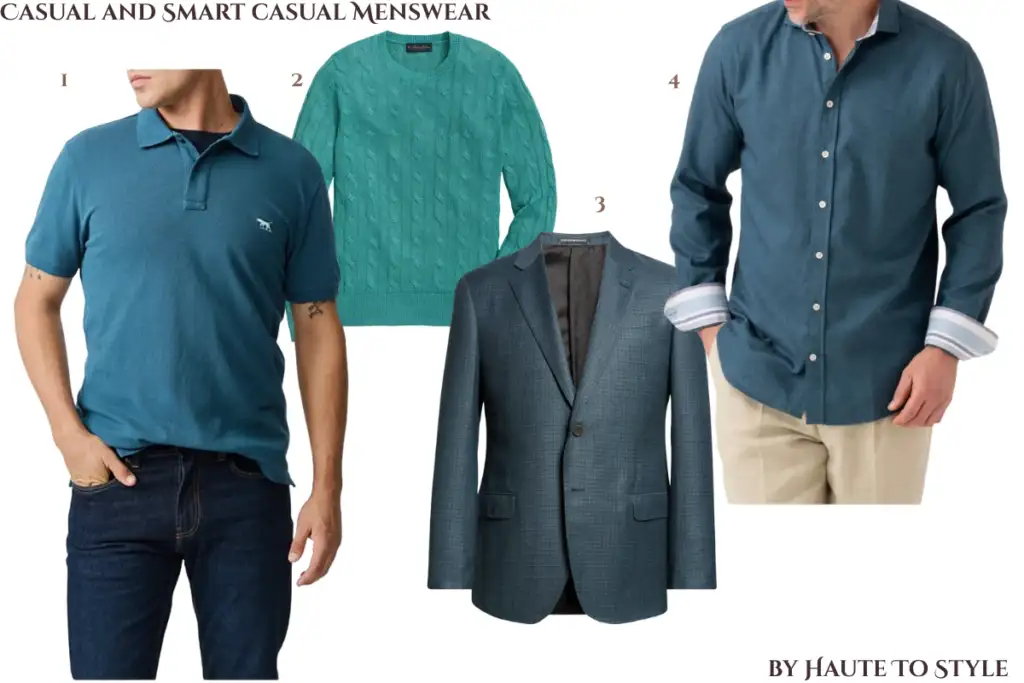
- The Gunn Polo – Teal | 2. Cable Stitch Linen Crewneck Sweater | 3. Teal Shadow Check Wool Sport Coat | 4. Cotton Merino Long Sleeve Shirt
For outerwear, a statement coat (in wool, leather, or technical puffer) in teal is versatile enough to work across seasons. Show galleries compile teal/blue-green coats from labels like Lanvin alongside sporty pieces, and technical brands are leaning into bold colours for performance rainwear. Use teal outer layers to elevate basics.
- Statement coats in teal (made from wool, leather, or performance fabrics) for versatile, seasonal styling.
Accessories
Try pairing a teal bag or shoes with cream, camel, grey, navy, white, or black. For bolder moments, use coral/red-orange accents (classic complementary theory) or metallics—gold warms greener teals, while silver flatters bluer ones, especially for events and wedding-guest dressing.
- Teal bags or shoes paired with cream, camel, navy, or black; accent with coral or metallics for a bolder touch.
Finally, if you want an easy win for 2026, buy one hero item (blazer, coat, or slip dress) plus one accent (bag or shoe) in teal: it aligns with the sustainability-minded, resilience-framing narrative behind the 2026 forecast while giving maximum outfit mileage across work, evening, and smart-casual wardrobes.
Frequently Asked Questions About Transformative Teal
-
What is Transformative Teal?
According to WGSN, Transformative Teal is the Colour of the Year for 2026. It’s a fluid fusion of blue and aquatic green that reflects nature, resilience, and an Earth-first mindset.
-
How do I find my perfect shade of teal?
Start by identifying your undertone. Cool undertones suit bluer teals, such as aqua or ink-blue. Warm undertones pair well with greener teals, such as jade, while neutral undertones can be paired with balanced mid-tone teals.
-
What colours pair best with Transformative Teal?
Teal pairs beautifully with neutrals like beige, camel, navy, and cream for a polished look. For bold pairings, try coral, amber, or Electric Fuchsia, or go tonal with navy and turquoise.
-
What are the challenges of wearing teal?
Teal can shift in different lighting conditions and may appear differently on the skin in photos. Always check fabrics in daylight, consider your undertone, and use accessories or layering to adjust saturation.
-
What are the must-have teal items for 2026?
Start with a hero item, such as a tailored teal blazer, a statement coat, or a silk slip dress. Add accessories, such as a teal handbag or shoes, to integrate the colour into your wardrobe easily.
-
Which fashion brands use teal in their collections?
Recent collections from Elie Saab, Lanvin, Casablanca, Qasimi, and Denzilpatrick have showcased teal in eveningwear, outerwear, and innovative tailoring on the runway.
-
Is teal suitable for work outfits?
Yes! A teal blazer or dress paired with classic neutrals like cream, charcoal, or navy offers a sophisticated yet modern look suitable for work or presentations.
-
Gift Ideas: Coffee Table Books for Every Home in 2025-2026
Generally speaking, a living room is the family hub, filled with family dinners, celebrations, and memorable moments. The living room may have several focal points; however, the coffee table is among the most important. The idea of a coffee table has a vibrant history. It started with the Ottoman Empire, where people used low tables…
-
Christmas Gift Ideas: Educational Growth Mindset Books for Children
Choosing Christmas gifts for children can be an overwhelming process, especially if you are trying to avoid plastic clutter and sugar highs. This year, I wanted to gift my kids something meaningful, inspirational and something that they can be used all year round. So that idea inspired me to create this gift book guide for…
-
Tall Dresses Guide: Fit Checklist & EU/UK/US/AU Brand Lists
All of these remarkable qualities — like instant presence & polish, layering without bulk, choices of maxi dresses & midi dresses, bigger print & texture range, accessory scale that sings, and trend versatility — are usually associated with one type of people—the people who can pull tall dresses off effortlessly. We all know these beautiful…
-
Haute to Style Blueprint™: Body – Online Body Shape Analysis
Half of the success in creating winning outifts is understanding geometry. When you match garment’s lines, shapes and placements to your proportions, everything looks intentional. Know the most flattering necklines, sleeve and hem lengths, print scale/placement, and colour-blocking for your shape, and you cut fitting-room time in half. How it works (quick + simple) With…
-
Pantone® Top Colours for A/W 2025/26 for Capsule Wardrobes
Colour is an essential part of any Fashion Week. It is always exciting to learn about upcoming colour trends to prepare for what is coming next in the world of fashion. With changes in materials, styles, and silhouettes comes a shift in a world of colour as well. Ten defining colours from New York Fashion…
-
Key Print Trends From Fall/Winter Fashion Weeks 2025–2026
Some people love to wear prints, while others are a bit sceptical; however, there is no doubt that prints add variety to any look and, subsequently, to any wardrobe. With the help of a specifically chosen print, it is possible to create a desired accent to highlight or conceal a particular part of an outfit.…

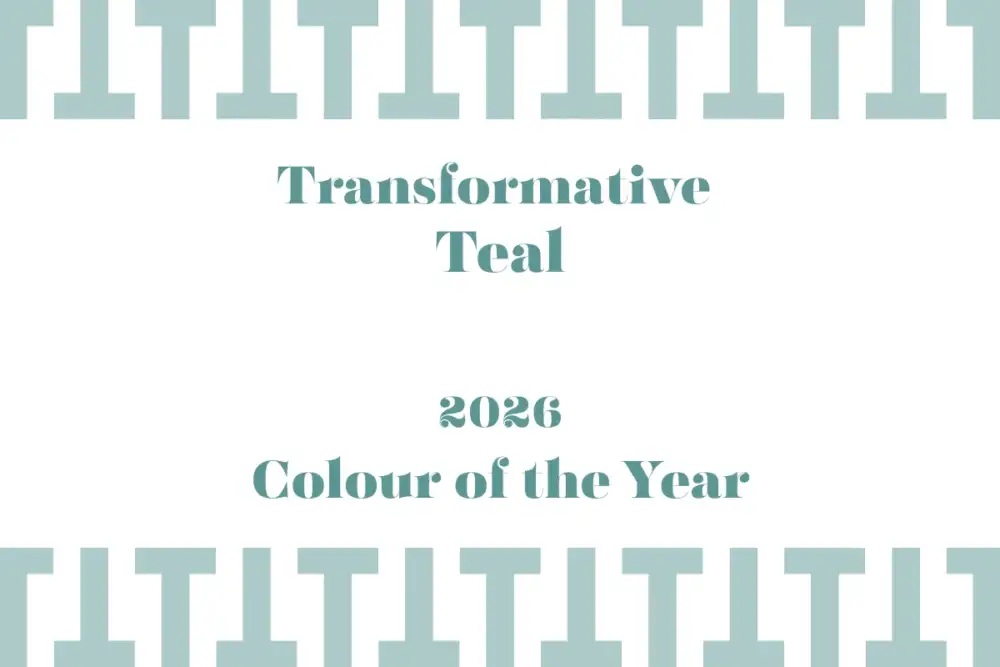

1 Comment